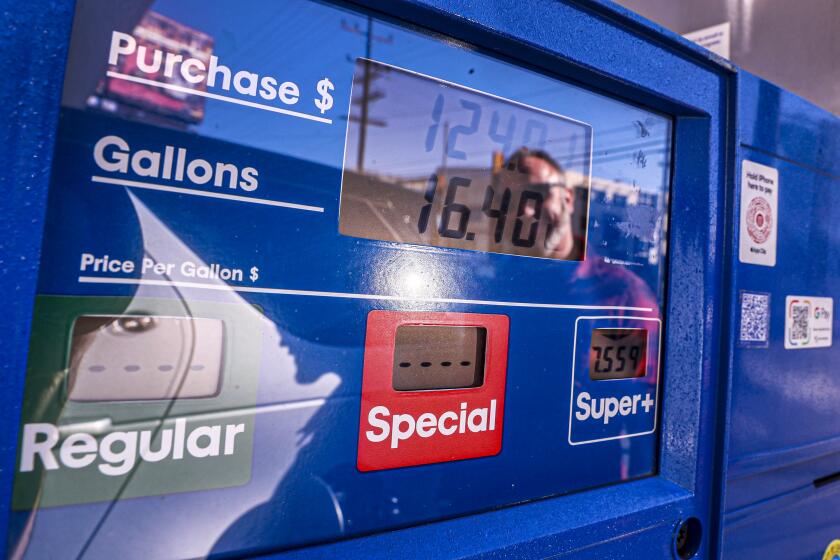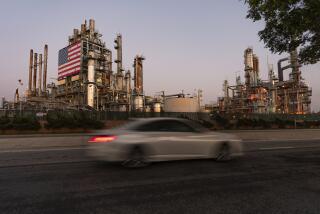Los Angeles gas prices drop for 15th consecutive day following ‘unprecedented rise’

- Share via
Gas prices in the Los Angeles metropolitan area on Tuesday dropped for the 15th consecutive day, with an average gallon of regular gasoline decreasing 1.3 cents to $5.849, according to figures from the American Automobile Assn.
That number was down from $5.96 just one week ago and $6.07 on March 28 — the highest average price ever recorded in the area. But it was still far costlier than the price on this day last year: $3.979.
California in March saw an “unprecedented rise in gas prices even compared to the rest of the country,” said AAA spokeswoman Marie Montgomery, noting that the Golden State was the only one in recent weeks to see prices in several metro areas above $6 a gallon. “Our market got very, very heated. ... Now it’s sort of falling back down to earth.”
Prices are also inching down statewide and across the nation, with the average American paying $4.098 for a gallon of regular, down from $4.176 a week ago, according to AAA.
Experts say the slow reversal of prices at the pump is largely linked to the lowering cost of crude oil, from which gasoline is made.
Those costs began shifting after several countries, including the U.S., announced plans to release barrels of crude oil from their emergency reserves in an effort to relieve soaring prices connected to the Russian invasion of Ukraine. President Biden at the end of March ordered the release of 1 million barrels of oil per day for six months.
Biden’s order to release of 1 million barrels of oil a day from U.S. reserve is a bid to control prices that have spiked after sanctions on Russia.
UC Berkeley energy economist Severin Borenstein said it takes some time for those releases to pass down to the retail level, “but we are seeing it slowly.”
“Basically we are dumping a million barrels a day into the world crude market, which is 100 million barrels a day,” Borenstein said. “That doesn’t sound like it would do a lot, but it actually can do a bit — particularly combined with releases from other strategic petroleum reserves around the world. That’s what’s pushing down prices.”
Last week, more than 30 member countries of the International Energy Agency pledged an additional 60 million barrels from their stockpiles, the second such release in just over a month, bringing the total to about 120 million. The U.S. will contribute about 60 million barrels to that effort as part of its larger drawdown.
Borenstein noted that the war in Ukraine isn’t the only factor behind the recent price spikes, which started surging at the end of last year after demand roared back from early pandemic slowdowns and overpowered supplies, months before Russia’s invasion.
Gas prices seem to have little logic, especially since Russia invaded Ukraine. Culprits? A combination of market forces, the “mystery gas surcharge” and more.
Local refinery disruptions — including a March outage at the Torrance PBF Energy refinery — also widened the gap between costs in California and those in other states. Although tanker load prices at the Port of L.A. typically run 10 to 20 cents higher than those in New York and near the Gulf Coast, the difference was as high as 90 cents in recent weeks, Borenstein said.
Montgomery, of AAA, noted that a fire last weekend near the Port of Benicia in Northern California could also cause some regional impacts, but said damage assessments are still underway.
In response to the soaring gas prices, Gov. Newsom last month outlined a proposal to provide gas rebates to Californian drivers. Meanwhile, climate experts have argued that now is the time to tackle fossil fuel dependency amid the worsening climate crisis.
Borenstein said he didn’t think Californians would see prices below $5 a gallon until the Russian invasion in Ukraine is stopped and sanctions are removed.
Still, he said, the release of the reserves should help continue to ease gas costs in the days and weeks to come, and will be particularly helpful to European allies who are highly dependent on Russian oil.
“I would very much expect prices to continue to decline,” he said, “because we are still catching up at the pump with the price declines upstream from the lower spot price and the declining price of crude. I think that has a ways to go still.”
More to Read
Sign up for Essential California
The most important California stories and recommendations in your inbox every morning.
You may occasionally receive promotional content from the Los Angeles Times.













